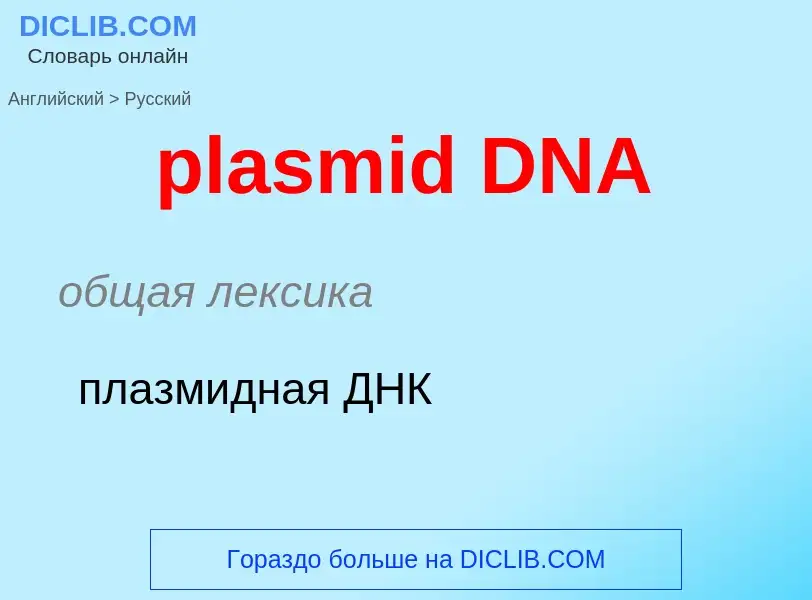Перевод и анализ слов искусственным интеллектом ChatGPT
На этой странице Вы можете получить подробный анализ слова или словосочетания, произведенный с помощью лучшей на сегодняшний день технологии искусственного интеллекта:
- как употребляется слово
- частота употребления
- используется оно чаще в устной или письменной речи
- варианты перевода слова
- примеры употребления (несколько фраз с переводом)
- этимология
plasmid DNA - перевод на русский
общая лексика
плазмидная ДНК
общая лексика
плазмидный вектор
['plæzmid]
общая лексика
плазмида
биология
эписома
существительное
биология
плазмида
эписома
общая лексика
сексдукция (трансдукция при участии полового фактора)
общая лексика
ДНК
дезоксирибонуклеиновая кислота
(Distributed Internet Application) распределённые приложения Интернет, архитектура DNA
(Digital Network Architecture) архитектура цифровой сети
сетевая архитектура, разработанная корпорацией Digital Equipment. Реализована в сети DECnet
синоним
Смотрите также
существительное
общая лексика
архитектура цифровых сетей
синоним
['s(j)u:pəkɔil]
общая лексика
суперспираль
спираль второго порядка
синоним
['s(j)u:pəkɔild]
биохимия
сверхспиральный (об укладке молекулы ДНК)
прилагательное
биохимия
сверхспиральный (об укладке молекулы ДНК)
общая лексика
рекомбинантная ДНК
Определение
Википедия
A transfer DNA (T-DNA) binary system is a pair of plasmids consisting of a T-DNA binary vector and a vir helper plasmid. The two plasmids are used together (thus binary) to produce genetically modified plants. They are artificial vectors that have been derived from the naturally occurring Ti plasmid found in bacterial species of the genus Agrobacterium, such as A. tumefaciens. The binary vector is a shuttle vector, so-called because it is able to replicate in multiple hosts (e.g. Escherichia coli and Agrobacterium).
Systems in which T-DNA and vir genes are located on separate replicons are called T-DNA binary systems. T-DNA is located on the binary vector (the non-T-DNA region of this vector containing origin(s) of replication that could function both in E. coli and Agrobacterium, and antibiotic resistance genes used to select for the presence of the binary vector in bacteria, became known as vector backbone sequences). The replicon containing the vir genes became known as the vir helper plasmid. The vir helper plasmid is considered disarmed if it does not contain oncogenes that could be transferred to a plant.

![[[Electron micrograph]] of a DNA fiber bundle, presumably of a single bacterial chromosome loop [[Electron micrograph]] of a DNA fiber bundle, presumably of a single bacterial chromosome loop](https://commons.wikimedia.org/wiki/Special:FilePath/DNA Under electron microscope Image 3576B-PH.jpg?width=200)



![DNA major and minor grooves. The latter is a binding site for the [[Hoechst stain]] dye 33258. DNA major and minor grooves. The latter is a binding site for the [[Hoechst stain]] dye 33258.](https://commons.wikimedia.org/wiki/Special:FilePath/DNA-ligand-by-Abalone.png?width=200)
![animated version]]). animated version]]).](https://commons.wikimedia.org/wiki/Special:FilePath/DNA animation.gif?width=200)

![B]] and [[Z-DNA]] B]] and [[Z-DNA]]](https://commons.wikimedia.org/wiki/Special:FilePath/Dnaconformations.png?width=200)

.jpg?width=200)




![[[Maclyn McCarty]] (left) shakes hands with [[Francis Crick]] and [[James Watson]], co-originators of the double-helix model based on the X-ray diffraction data and insights of Rosalind Franklin and Raymond Gosling. [[Maclyn McCarty]] (left) shakes hands with [[Francis Crick]] and [[James Watson]], co-originators of the double-helix model based on the X-ray diffraction data and insights of Rosalind Franklin and Raymond Gosling.](https://commons.wikimedia.org/wiki/Special:FilePath/Maclyn McCarty with Francis Crick and James D Watson - 10.1371 journal.pbio.0030341.g001-O.jpg?width=200)
![Interaction of DNA (in orange) with [[histone]]s (in blue). These proteins' basic amino acids bind to the acidic phosphate groups on DNA. Interaction of DNA (in orange) with [[histone]]s (in blue). These proteins' basic amino acids bind to the acidic phosphate groups on DNA.](https://commons.wikimedia.org/wiki/Special:FilePath/Nucleosome1.png?width=200)




![The Eagle]] [[pub]] commemorating Crick and Watson The Eagle]] [[pub]] commemorating Crick and Watson](https://commons.wikimedia.org/wiki/Special:FilePath/TheEaglePub-Cambridge-BluePlaque.jpg?width=200)





